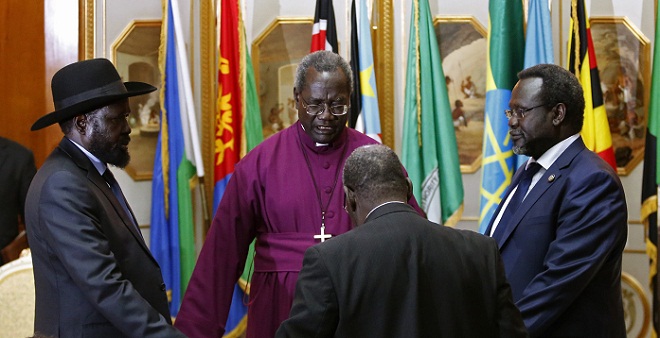
Juba, South Sudan | AFP |
South Sudan rebel chief Riek Machar finally returned to Juba on Tuesday and was sworn in as vice-president of a unity government formed to end more than two years of civil war in the world’s newest country.
His return (CLICK HERE FOR “Machar Return” STORY), delayed by a week, is potentially one of the most significant steps towards peace since a repeatedly broken deal was brokered in August 2015.
Independent since 2011, the conflict in the world’s newest nation has pitted government troops loyal to President Salva Kiir against those of Machar, who was sacked as vice president five months before war began in December 2013.
Tens of thousands have been killed and more than two million people forced from their homes.
The UN says South Sudan ranks “lower in terms of human development than just about every other place on earth”.
Here are key events in the war.
– 2013 -December 15: Heavy gunfire erupts in Juba, where tensions have risen since July when Machar was fired as vice-president. Kiir blames Machar for an attempted coup, but Machar denies this and accuses the president of purging his rivals. Fighting spreads and rebels seize key towns.
– 2014 -January 10-20: Uganda sends troops to back Kiir. Government troops recapture the northern city of Bentiu, capital of oil-rich Unity State, and Bor, capital of the eastern state of Jonglei.
April 15-17: More than 350 civilians are massacred in Bentiu and Bor, according to the UN.
August 26: A UN helicopter is shot down, with three onboard killed. Each side blames the other. Over 50 aid workers have been killed in the war.
– 2015 – February 1: Kiir and Machar sign a new agreement to end the fighting, the latest in a series of deals. Like the others, it is rapidly broken within days.
June 30: South Sudan’s army raped then torched girls alive inside their homes, a UN rights report says, warning of “widespread human rights abuses”. Rebels have been accused of similar atrocities.
July 2: UN and US sanctions decided against six leaders from both sides.
August 17: Machar signs a peace deal in Addis Ababa.
August 26: Kiir signs the peace accord, but issues a list of “serious reservations”. Fighting continues.
October 3: Kiir nearly triples the number of regional states, undermining a key power-sharing clause of the peace agreement.
October 28: African Union investigators list atrocities committed, which include forced cannibalism and dismemberment.
November 5: UN experts warn that killings, rapes and abductions continue and that both sides are stockpiling weapons. Over two dozen armed groups are involved in fighting characterised by shifting alliances, opportunism and historic grievances.
November 27: Some 16,000 children have been forced to fight, amid a growing humanitarian crisis, the UN says. More than 2.8 million people, almost a quarter of the population, needs emergency food aid.
– 2016 -February 8: UN agencies warn at least 40,000 people are being starved to death in war zone areas, with rival forces blocking aid.
I met with Dr. Riek Machar and his wife Angelina Teny at Masindi state lodge yesterday.Peace in SSudan is vital pic.twitter.com/yC61aODKsK
— Yoweri K Museveni (@KagutaMuseveni) January 26, 2016
February 12: Kiir reappoints Machar as vice president.
April 11: A 1,370-strong rebel force completes their arrival into Juba ahead of Machar’s expected return. A day later South Sudan’s rebel deputy chief Alfred Ladu Gore returns to the capital.
April 25: South Sudan’s top rebel military commander Simon Gatwech Dual returns as well.
 The Independent Uganda: You get the Truth we Pay the Price
The Independent Uganda: You get the Truth we Pay the Price


